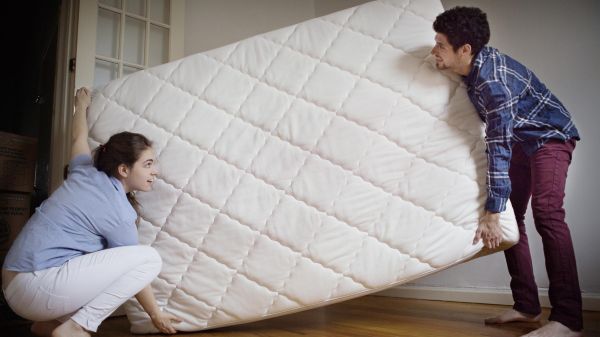How to fix a saggy mattress for a more comfortable night’s sleep
Need to know how to fix a saggy mattress? Look no further!

If you’re looking up how to fix a saggy mattress, odds are your mattress has seen better days. It happens to the most of us at some point, even if you invested in the best mattress; one day you realize the support has gone and you sink into a dip. It might not seem like a big deal, but this dip can affect your sleep and even cause discomfort at night — after all, you’re not sleeping on a flat surface anymore.
Most consider this problem to be a lost cause; how can you fix something that’s bent out of shape? While you can't exactly fix a saggy mattress (the only way to properly fix it is to send it back to the manufacturer for repairs while still under warranty), there are steps you can take to improve this situation. And it’s certainly worth making the effort to do this if you’re not prepared to buy a new mattress, much like repairing a squeaky bed. Here, we take you through what you can do to 'fix' a saggy mattress.
Why has my mattress started to sag?
Unfortunately, all mattresses will inevitably sag over time. It’s a result of the pressure and weight we put on the surface throughout the night. The rate at which each mattress will dip depends on the type of mattress in question and the person sleeping on it. Even personal sleeping habits can affect where the dip will form — someone who sleeps on their side will put more pressure on the mattress via the hip. Whereas there will be less sagging if you better distribute your weight.
In my experience, both foam and spring mattresses have sagged at a similar rate, but this ultimately comes down to the quality of your mattress. It should also be noted that mattresses which are firmer or denser will likely last longer than softer designs when it comes to sagging.
How to 'fix' a saggy mattress

1. Turn the mattress around — It sounds like common sense, but this is the first step to take if you’re dealing with an annoying dip. By rotating the mattress 180 degrees, the dip will appear lower-down on the other side of the bed. Not ideal if you’ve got a partner sleeping on the other side, but it’s much more comfortable down by their feet versus your back.
You should aim to rotate your mattress every three to six months in general to keep it in good condition. Bear in mind, we’re talking about rotating, not flipping. Not all modern mattresses are designed to be flipped, so check this first before attempting. If it’s a layered design or a hybrid with zoned support, don't flip it.

2. Try one of the best mattress toppers — A mattress topper essentially adds another layer on top of your bed for more comfort. These are a brilliant alternative if you’re not prepared to buy a new mattress, yet want to improve the conditions of your current one. There are different types available to suit your preference, including down, foam and even wool. True, you will likely still feel the dip through the topper, but the effects of it will be less severe.
Sign up to get the BEST of Tom's Guide direct to your inbox.
Get instant access to breaking news, the hottest reviews, great deals and helpful tips.
Note that bed toppers should not be confused with the best mattress protectors. A topper adds comfort, whereas a protector is designed to simply safeguard against spills and stains.

3. Use pillows to help — If you’re dealing with a precise area of sagging then a few well placed pillows can really help. By using one of the best pillows, you can reinforce the support wherever needed, be it around the hips or your back. Dense foam pillows would be best for this purpose, as they provide the best support.
This isn’t a permanent solution (a short-term fix at the most), but it should ease the issue until you’re ready to buy a proper replacement.

4. Get a new foundation — Sometimes the mattress isn’t even the problem; take a look at the foundation instead. If it’s uneven, then it’s contributing to the sagging. If there are slats, these should be evenly spaced apart to offer proper support. Foundations with four legs also won’t offer as much support to the center of the mattress as those with six legs.
If you need to invest in a new foundation, consider checking which type would suit your mattress before purchasing. This will help extend your mattress’ life, and most manufacturers include this information on their website so it's easy to find out.
Alternatively, you could try placing a bunkie board under your mattress to add extra support and a solid surface if your mattress is bulging through the slats of your bed.

5. Check the warranty — Don’t forget, if your mattress is relatively new it’s likely still covered under warranty. In which case, you may be within your rights to get a replacement. Contact the brand to see if you’re covered, or look at the terms and conditions on the manufacturer's website as many will state the depth of sinkage that is and isn't covered by a warranty.
When buying a new mattress, it’s always worth checking the guarantee that comes with it so you know what's covered. We explain this more in our feature on how mattress warranties work.

6. Get a new mattress — If all else fails, it’s time to invest in a new mattress. Even the best mattress won’t last forever (the average lifespan is six to eight years, depending on the materials used to make it), so this is something you will have to occasionally replace.
There are certain steps you can take to extend the life of your mattress though, such as learning how to clean a mattress properly and routinely rotating it.
Save up to $750 on mattresses at Nolah Sleep
We've teamed up with Nolah Sleep to bring you a VIP discount on its range of memory foam and hybrid mattresses. Use the code TGNOLAH at checkout and you'll save up to $750 on a Nolah mattress, designed with innovative cooling and comfort tech to support every sleep position. You’ll get a 120-night trial and free shipping too.
This article is part of Tom’s Guide’s Sleep Awareness Week 2022 celebration, running until Saturday 19 March. Stay tuned for plenty of sleep tips, advice and expert-rated products to help you sleep better this year.

Katie Mortram used to be a Homes Editor for Tom's Guide, where she oversaw everything from kitchen appliances to gardening tools, as well as smart home tech. Specializing in providing expert advice for cleaning and home manintenance, she now works as Household Advice Editor for Good Housekeeping.


